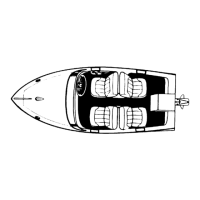6B-20 - CLOSED COOLING MODELS 90-823225--1 1096
Testing for Cylinder Head Gasket
Leak
A leaking head gasket will cause combustion gas to
be forced into the cooling system. The mixture of
coolant and tiny air bubbles is a poor heat conductor
and will overheat an engine quickly. Compression
tests or cooling system pressure check normally will
not detect the leak because the test pressure is far
below the combustion pressures which cause the
leak. An effective test is as follows:
IMPORTANT: Run boat in lake for this test. It is
best to run the engine at or above cruising speed
during this test. Usually a failed head gasket will
not cause the engine to overheat below cruising
speed.
1. Install a clear plastic hose between the reservoir
and coolant recovery bottle. Use a 2-3 ft. (61-91
cm) long hose for this test.
2. Route this hose so a “U” is formed.
3. Put enough coolant into hose to fill the center 4
or 5 inches (10-13 cm) of the “U.”
4. Observe the “U” while the engine is running.
a. During Idle and Warm-Up: Some coolant
and/or air will leave the reservoir.
b. During Cruising Speed (2500-3500 RPM):
Coolant and/or air leaving the reservoir
should stop after approximately five minutes
running at a given RPM. A leaking head gas-
ket will produce air bubbling through the “U,”
going to the coolant recovery bottle. The fre-
quency and size of the bubbles will depend
on the size of the leak.
c. At Higher Speeds (4000+ RPM): Normal op-
eration is the same as described in “b” above.
A failed head gasket will cause the bubbles to
come faster and may be accompanied by vio-
lent, intermittent bursts of coolant.
It is important not to confuse normal warm-up expan-
sion with a failed head gasket. Normal warm-up pro-
duces an intermittent flow of coolant which will stop
within approximately five minutes at a given RPM. A
head gasket leak will not stop because the one thing
that marks a failed head gasket is the continued pas-
sage of air. This may be accompanied by violent, in-
termittent bursts of coolant leaving the reservoir. If
coolant continues to flow (not in violent, intermittent
bursts) from the reservoir at cruising speed, some-
thing else besides the head gasket is causing the en-
gine to overheat.
Testing Heat Exchanger
FOR INTERNAL LEAK: An internal leak will cause
coolant to go into the seawater circuit when pressure
is put on the closed cooling circuit.
1. Remove a seawater hose from the exchanger.
Do not drain the exchanger.
2. Pressurize the closed cooling circuit to 14-20 PSI
(97-138 kPa) with a radiator tester.
3. If seawater begins to flow from the nipple there is
a leak.
FOR BLOCKAGE:
IMPORTANT: Seawater flows THROUGH the
tubes in the exchanger. Closed cooling coolant
flows AROUND the tubes.
1. Remove end caps and inspect for any blockage
in the seawater circuit (broken impeller blades,
weeds, etc.).
2. Remove closed cooling circuit hoses and inspect
the tubes just inside the nipples. Because the
complete exchanger cannot be inspected, the
heat exchanger should be replaced if blockage is
suspected.
Testing Pressure Cap
Pressure cap is designed to maintain a pressure of
approximately its rated capacity (refer to “Specifica-
tions”) in closed cooling section once engine has at-
tained operating temperature. Cap should be
cleaned, inspected and pressure-tested at regular
tune-up intervals or whenever cap is suspected of
maintaining improper pressure as follows:
!
WARNING
Allow engine to cool before removing pressure
cap. Sudden loss of pressure could cause hot
coolant to boil and discharge violently. After en-
gine has cooled, turn cap 1/4 turn to allow any
pressure to escape slowly, then push down and
turn cap all the way off.
1. Carefully remove pressure cap from reservoir or
heat exchanger.
2. Wash cap with clean water to remove any depos-
its or debris from sealing surfaces.

